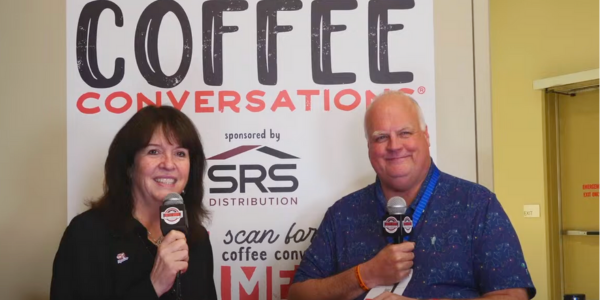UP TO THE MINUTE
Metal Market/Trends Survey - PODCAST TRANSCRIPT
September 2, 2024 at 3:00 p.m.Editor's note: The following is the transcript of a live interview with Paul Trombitas of FMI. You can read the interview below, listen to the podcast or watch the recording.
Intro: Hello, welcome to Contractor Outlook Newscast from The Coffee Shops. This is Heidi Ellsworth, and this is all about what's happening outside our industry along with inside our industry. So really talking about construction, politics, weather, forecasting, economics, all the things that are indicators outside that really make our business every day turn. But sometimes we don't know all the details, so we're bringing experts from outside the industry but who are also kind of insiders to talk to us about what is happening. So today I am so excited. I've watched this gentleman speak many times. He has great information. Paul Trombitas of FMI. Paul, welcome to the show.
Paul Trombitas: Heidi, thank you for having me. I'm excited to be here, and appreciate the introduction and having me on the show.
Heidi J. Ellsworth: Oh, I love it. Every time I see that you're on the agenda to speak, I'm like, "Ah, I'm going to get some great data, some great statistics." FMI just does such a great job. So why don't we start with an introduction? If you can introduce yourself, tell us what you do at FMI and a little bit about the company.
Paul Trombitas: Absolutely. So as Heidi mentioned, I'm Paul Trombitas. I'm one of the partners at FMI. Just a little bit of background on FMI, we are management consulting and investment banking firm. What's unique about the company is, for the 70 years we've been in business, the only industry we focus on is construction. So our clients are general contractors, trade contractors, architects, engineers, distributors, building product manufacturers and any of the associations that are involved in the industry. And I lead our team that's focused on building products.
As you can imagine, that's a wide range of products. So anything from roofing to flooring, to windows, doors, sanitary drainage and really any manufactured product that goes in the construction of a building or infrastructure. Really excited today to be on the show and share FMI's perspective on the market and what we're seeing down the road. Really, as we've seen over the last several few years, the big topic, what really seems to stand out is change.
Heidi J. Ellsworth: Yeah.
Paul Trombitas: The quote around the only thing that's constant is change really resonates. When we look at the construction space over the next several years, it's just that it continues to evolve. So really excited to share our perspective.
Heidi J. Ellsworth: I love it. Every time, I mean when I think about, I've seen you a lot of times at the Metal Construction Association presenting on what's happening in metal buildings and metal roofing, metal siding, all of that, but it's really interesting because you get that big picture. I love it when you say you focus on construction, because so do we and it kind of all fits together, but what are you looking at right now for the overall construction industry outlook?
Paul Trombitas: Absolutely. Just to kind of piggyback on that and what is unique about the company is, the consultants and the banking professionals at FMI, they're living day in and day out in construction, architect, building product, manufacturing firms. So they really were able to get that boots on the ground perspective. So when we look at our recently released Q3 2024 outlook and the total volume of forecast construction spending, so from '24 to '28, total growth of about 15%. We look back over the past few years, so from '21 to '23, we certainly saw substantial growth. What we anticipate moving forward, really a slowdown in growth and not necessarily a decline, but really a change in growth from 6% down to 3% and really starting in that '24 to '25 period through '26 and then a return to growth in '27 and '28. What's important to really consider here is, how does that factor in by sector?
Heidi J. Ellsworth: Yeah.
Paul Trombitas: So combined construction, we think of residential, non-residential, non-building and if we take the residential space over that forecast period, what we're seeing is, single family actually is faring really well. We see a 7% growth rate compound annually over the forecast. What's a challenge is really the multifamily marketplace. We saw a big buildup over the past several years and we see a decline there in spending through '24 really to '26. And that's going to have a really big impact on the overall marketplace, because residential represents 45% of overall construction spending.
Paul Trombitas: Now, if we turn and look at the non-residential segment, we saw substantial growth in '22 and '23, really driven by a number of things, heavily the unprecedented growth in high-tech manufacturing, EV, battery, semiconductor, but also data centers. So we do see a bit of a slowdown in the '25 and '26, but again, a return of growth in '27 and '28. And then on the non-building side, so very focused on infrastructure, very consistent market and a lot of that's driven by IIJA funding, the government incentives. So that market really is going to maintain consistency and see growth over that forecast period. But what we'd like to say, and I think is a great way to think about, because no one chases a hundred percent of the marketplace.
Heidi J. Ellsworth: No.
Paul Trombitas: We think about it almost similar to the Dow in that it's a great way to gauge the health, the wellness of the overall market in your portfolio of segments and projects and products is going to be different than the overall market. And it's a way to gauge how you're performing against the marketplace. The other piece that I think is really important is, how are firms going to react? So if we look over the forecast period and if we see substantial decline, does that mean firms are going to be a lot more competitive? Are they going to really start to focus on getting projects just to fill backlog? Or if we see substantial growth, are they going to be more strategic and more selective in their project pursuits? It also impacts building product manufacturers, the sureties, the banks and how they see the market. So it's a great way to get a sense of what are going to be the reactions in the marketplace. So from a big picture perspective, that's what we're seeing right now in the market.
Heidi J. Ellsworth: I think one of the things you said that's the most interesting to me is the fact that multifamily could soften for the next couple of years.
Paul Trombitas: Mm-hmm.
Heidi J. Ellsworth: To me, when you hear about how much housing is needed and you just think about the real estate prices and everything that's going on out there, that really surprised me. What are some of the indicators that are really pointing that way? Do you think we overbuilt because of the need? Or is it just ... What is it? Because it seems like the demand is out there for housing.
Paul Trombitas: Oh, that's a great question. It certainly isn't, and there's no ... I was watching the CEO of one of the major building product manufacturers, and certainly demand isn't going away. We still have demand for housing that we haven't addressed. One of the big things on the multifamily side, it really is dependent on geography and where you are. There are certainly markets where you see high net migration that are continuing to expand on the multifamily, but we definitely saw a strong growth over that '22, '23 period. So to some extent, it was a overbuilt, but it just really depends a lot on where you are geographically. But when you mentioned, are there indicators or ways we think about the market in addition, just the overall sizing, we really look at five indices.
So there's three of which that are proprietary to FMI. So we have a non-residential construction index, which we call NRCI. We have our civil infrastructure index. And then we have a joint index with CERT and FMI, which CERT is the largest general contractors and engineering firms in the US.
Heidi J. Ellsworth: Okay.
Paul Trombitas: We also look at NHB and AIA, and these are all diffusion indices. So anything above a 50 is growth, anything below 50 is decline and 50 is stable. What's great about these is, they're really looking a quarter or two down the way. And I really like AIA because they have a little bit more of a long-term perspective. They have ties closer to the owners and what they're seeing. It's a great way to get a sense of how folks are feeling in the market, their sentiment indices. And it also contributes, again, going back to how folks may react and what are the consequences.
Paul Trombitas: If we look at the NAHB Home Builder Index, if it continues to see a downtick over the next five months or the NRCI, we see a downtick over the next two quarters, are firms going to be more aggressive on pricing? Again, are they going to be more selective on what they pursue? It really ties into how folks are positioning in the market and certainly tying back to the multifamily question of, it goes back to where the growth is occurring, particularly around the geographic standpoint. And we look at the urbanization and the net migration and where those concentrations are, and that's where we see a lot of growth as opposed to areas that are seeing a lot of out migration.
Heidi J. Ellsworth: Right.
Paul Trombitas: So there's a number of factors that really tie into that.
Heidi J. Ellsworth: Well, I also think when you're talking about this too, interest rates, because you're talking about NAHB, I mean I just know so many young people right now who want to buy a house but are waiting for interest rates to go down. And that could be new communities that are being built, new construction or just trying to fix up, which is in roofing and in a metal and a lot of different things, that's the key. Is there real estate selling or not selling? How much of that do you think is really influencing all of these areas?
Paul Trombitas: It has a huge impact both on the residential side, the non-residential side, interest rates, affordability, that has a major impact on home buying. What we have seen is a shift in, really interesting, you look at square footage of homes over the last 10 year and it has declined pretty substantially. Folks now are purchasing homes that are smaller or they have less of the upgrades where you used to be able to upgrade a kitchen and a bathroom and the living room, whereas now you can upgrade a total package. It's the high end, it's the mid-tier or it's the low end. So the options are increasingly limited. But the other factor is what we see on the remodel and renovation side, is in three and five years when folks that purchase homes where maybe it wasn't exactly what they wanted, but they have the opportunity to upgrade and retrofit their homes and we see that over the long term, there'll be a shift in greater opportunity within that renovation market.
Heidi J. Ellsworth: Yeah, I've been seeing some of those same things. Lastly, just before we move off this topic, one of the things, I love what you said about the AIA because we all think about it, "Okay, what are the architects doing? What's their pipeline? If they have a good strong pipeline, it's coming our direction." But do you see that the architectural kind of pipeline, is it slowing down a little bit? Where do you see that at?
Paul Trombitas: So we've seen it, it's below 50, which would be in the contraction phase, but it has slowly, it is not a drastic drop and it really is on the line of 50 over the last several months. So not a substantial change. And it's right below that stable line. Again, I hate to repeat it, but it really kind of goes back to where you are and the markets that you're participating in and opportunity that's available.
Heidi J. Ellsworth: Yeah.
Paul Trombitas: For instance, I was talking to an overhead door manufacturer that is in the Midwest and they were saying, "We're seeing a lot of slowing of growth and really having a challenging time to win new business." And then on the opposite side, I was talking to a door manufacturer that's in the Southeast and they can't fulfill demand fast enough.
Heidi J. Ellsworth: Yeah.
Paul Trombitas: It just goes to where you are and demand in the marketplace. It is an interesting dynamic in construction, in itself, is such a localized industry that what is happening in New York is going to be completely different than Nashville, than Boise, than Charlotte, than Nashville. So I kind of go back to that again. But overall, we see it really right around that stable mark for the market.
Heidi J. Ellsworth: And weather, all these things are regional and are affecting what's happening. So you're right. It's just there's so much. Okay, one of the things you talk about as I was looking at your studies and different things that I find so interesting is you talk about a new economy compared to an old economy. Can you talk about that a little bit and what you're seeing as new and going forward and what's kind of old, and I wouldn't say dying out, but definitely not growing?
Paul Trombitas: Absolutely. So when you look at the total construction market, it's almost like looking at the surface of the water, right? What's really going on is what's below. So we've bucketed the non-residential sectors really into two areas. It's the new economy and the old economy. And that new economy really represents the Z shift in the way the market is trending. These segments are less impacted and influenced by the overall economy, and they're more driven by societal, demographic, technological trends. So you think about high-tech manufacturing, data centers, warehousing, logistics, all being driven by things outside of just the overall economy versus you have the old economy, which is kind of the way that we used to do things. It's a little bit dated. We haven't seen a lot of innovation, I think, of movie theaters or even hotels and shopping centers. But what is interesting though, you have to think about what are some of the unique dynamics within each of those.
Paul Trombitas: I'll give you, it's kind of a silly example, but I think it's a really interesting one. Take movie theaters for example. During COVID, they were substantially hit and it was not a great place, not a great market to be in. In particular, I remember traveling and calling my wife and I said, when I get home, I'd been on the road for a number of weeks and told her that I wanted to take my son to go see one of the new Disney movies that was coming out. It was Pinocchio. She says, "Well, we already watched it. So the same day we went to theaters is the same day they released it on the streaming service." Now take that. So in order to think differently, AMC, for example, partnered with Taylor Swift. So you think about a Taylor Swift concert, average concert goer pays $1,300 a ticket. With a partnership that AMC had with Taylor Swift, it was $26 million in revenue on the first day.
Heidi J. Ellsworth: Geez.
Paul Trombitas: The record-breaking volume of ticket purchasing of their history. You think about the implications for that on the movie theater industry from retrofits to upgrades and what does that mean long term? Are other artists going to take a similar route and is that a merging opportunity? So it's interesting to see these unique dynamics within the market and what's going on as a result of these societal, demographic, technological changes. Looking at data centers and high-tech manufacturing, it's not anything new and we're seeing that over the market, but it's really starting to peel back the onion and what are some of those unique, almost niche markets, if you will and how we start to think about that separation in the market versus the new and old economy.
Heidi J. Ellsworth: Yeah. That makes so much sense. Some of the old economy, like you said, is rethinking itself and becoming a new economy as we look at it. But the ones that are not are kind of being left behind, that just are ... You know?
Paul Trombitas: Right.
Heidi J. Ellsworth: Speaking of motel, hotels, I just saw the motel flip. Now that's a big thing in construction where, at least on HGTV, it was, they go in and they take these old motels and they flip them into these really cool boutique places to stay. So it's interesting to start seeing some of this, how things are changing, how they're moving in those economies. I loved how you drew that out. I thought that was so good.
Heidi J. Ellsworth: Okay, we already talked about this just a little bit, but I want to revisit it because I am seeing it so much, but there is definitely a migration in population, whether it's due to politics, weather, job opportunities, but also remote working. Right? You can live anywhere now. So that is driving people to live maybe in places that they haven't been before, long as they can get internet. What are you seeing and how big of an influence is this going to have on our economy overall in the next five to 10 years?
Paul Trombitas: Great question. So if you ask our economists what's the one indicator of construction growth, he'll simply say it's where the people are going.
Heidi J. Ellsworth: Yeah.
Paul Trombitas: If you look at over the last 20 years, net migration trends, you see Arizona, Texas, Florida, the Carolinas, all having substantial net migration into the states. And then you see California, Illinois, New York having substantial out migration in those states. And that impacts the volume of construction because particularly when you think about the infrastructure needed, the education systems, so many factors tie into that. The other piece of that is, when we look at where construction is occurring from a geographic perspective, this is fascinating in that we have 400 metropolitan statistical areas in the United States, slightly under 400. Of those, there are 12 that represent 35% of spending.
Heidi J. Ellsworth: Wow.
Paul Trombitas: Add on the next 10, so not even the top 25, it's 22, 50% of spending. So it really goes into where you are matters because that urbanization, that concentration of spending. And as people continue to migrate to states and see higher net migration in those areas, we're going to continue to see that urbanization continue. The other piece is, these become hotspots for contractors, for architects, for distributors, for building product manufacturers. Well, let's go into that market. Well, first question we ask is why. Are you going with a strategic partner? Do you have a client taking you there? Because the last time, and we jokingly say, the last time we will ask anybody in those markets is, I haven't heard them say, "You know what we need? Another market participant."
Heidi J. Ellsworth: Yeah.
Paul Trombitas: It really goes to the question of, why are you going to the markets? Do you have competitive differentiation? Because it is considerable effort into a new market. So do you have the right strategic insight on that market? What are the trends in terms of what are the segments? So is it education? Is it health care? Is it commercial? Is it office? And then do you have the right partners? And can you gain a foothold in those marketplaces? I think we see this growth in a number of outside of the primary 12, the secondary, even tertiary geographies, but it comes down to are you pursuing these based on good market insights and do you have the right potential positioning, the right partners and the right competitive advantage to really take that opportunity on?
Heidi J. Ellsworth: You said this earlier, and I think this also goes with this, is are you also able to differentiate your company to stay with the trends? So if you are doing only multifamily, what are you doing to look at maybe some single family or some non-residential? Getting a little bit more into the commercial or wherever that may be. I think that is really important too. You made this point already, but I just loved it, don't get too stuck in one segment because that segment may go down for a while and that's not good for your business.
Paul Trombitas: Absolutely. The other thing that I didn't mention is, if you are in those geographies, how are you fortifying the position? Are you diversifying? Are you making sure you have those strong relationships and are you maintaining those? Because to your point, it's a cyclical industry and how are you going to offset those years that may be more challenging for one segment? And do you have the diversification to continue growth and viability of the organization?
Heidi J. Ellsworth: Right. I think also staying up with what's happening from an overall level, whether that is sustainability, looking at that, what's happening, but there are some key trends right now that you talk about that are impacting the market. And I would love for you to visit those. Because I found them fascinating, just like different ways of thinking about them, sustainability being one of them. So what are those trends that people should be aware of?
Paul Trombitas: Certainly. So I'll start with the sustainability topic and this is always an interesting conversation when you ask folks. It's certainly a top of mind topic. Sustainability is on everybody's to-do list, if you will.
Heidi J. Ellsworth: Yes.
Paul Trombitas: But what's interesting is, when you talk to folks, how they define sustainability varies person by person. So the three main areas that we're hearing more of is, is it the energy transition and energy efficiency? And how clear are folks on what that means, what that looks like? What are the operational implications for facilities around electrification, improvement around building performance standards and how are we achieving that? Certainly, there are the right projects and I think it really boils down to how it fits into our portfolio and is it the best approach to our projects?
Paul Trombitas: And then you have IRA, DOE, a lot of government incentives. So with IRA, you the 179D tax credit, which provides a very favorable tax credit if you reduce your energy consumption by 25%. You have DOE that has, I believe in November, they launched the first tranche of funding, it's for states to address their energy and zero energy codes. And then they launched the second tranche earlier this year that really focused on building performance standards. So you think about building products and the innovation that's going into them around addressing energy efficiency and how do we make buildings more resilient, more effective and operate to a higher degree.
Paul Trombitas: And then the third piece is a topic around decarbonization, which is a really interesting one, because are we talking about net zero? Are we talking about embodied carbon, operational carbon? For this one, particularly around embodied carbon, it really is early days in that there's not a lot of standardization around how products are compared. It's not necessarily equitable across all product types. So you have a group of owners that are really focusing on assessing products on embodied carbon and how they procure versus another group that aren't necessarily clear on what embodied carbon is. So it really depends on the owner and who's driving that emphasis.
Paul Trombitas: There's several ... For instance, there's a major healthcare system that we're working with a client and they went into the interview and the first question they had in the interview was, how are you going to address embodied carbon on this project? Versus if you go to a very price-driven marketplace, less likely they're going to pay a dollar or two per square foot because of lower embodied carbon product.
Heidi J. Ellsworth: Right.
Paul Trombitas: So it's still early days, the education process, really understanding what it means and how it ties into the overall sustainability framework. And I think there's still a lot of clarity that is coming for that. When we say sustainability, is it around the energy efficiency? Is it around the incentives? Is it around decarbonization?
Heidi J. Ellsworth: We're seeing that so much in roofing. I can tell you, in the roofing area, is it durable? Is it long-lasting? Is it performance product? Is it reflective? Is it recyclable? Everybody just kind of captures their one thing. So I think from a contractor, whether you're roofing or general contractor overall, you have to ask some of those questions because-
Paul Trombitas: Absolutely.
Heidi J. Ellsworth: People kind spin it to however it works for them. I'm not saying that in a bad way, I'm just saying you have to be aware that, of course, they're going to look for. And if everybody does a little bit something that way, then at the end of the day, the earth is going to be better because at least people are having the conversation now, which wasn't happening before.
Paul Trombitas: Oh, absolutely. It's making the right strides and really making sure that we're thinking about it for the best benefit of the owner, the building and how to most effectively implement those initiatives.
Heidi J. Ellsworth: Yeah. Yeah. So what are some of the other key trends? Because I know there's some other really interesting ones.
Paul Trombitas: So one of the one that is close to my heart is the use of alternative delivery methods, in particular, design build. I've spent a lot of time working with DBIA over the years and looking at the growth in design build. We certainly see continued growth in the use of design build, largely driven by complexity of projects. And that's not just big large projects, it's complexity, number of stakeholders, systems. Buildings overall are just more complex in the systems and processes that are going into them or very complex in looking for outside organizations that can bring innovative solutions to address the needs of the project.
Paul Trombitas: Here's one example though. There's an Ivy League school that is increasing their student population by 20%, which has not happened before. Along with that is, they have a $5 billion capital program to do that and they have a carbon-neutral goal by 2046 and they want to do it all design build. So how do we best address that? And that's continuing to show this emphasis on bringing the right folks early on in the process to identify what is the right solution, what are the right technologies, the right products to achieve the goals of that owner.
Heidi J. Ellsworth: Yeah.
Paul Trombitas: The other interesting piece I think for design build, for me in particular, is just in the last two to three years, the number of building product manufacturers that we've had reach out and ask, we continue to see the trend in design build and we want to get a seat at the table. We want to be the first call that gets involved early, provides design input on what the best products are, how to best position. So when you think about this growth and continued demand around design build, building product manufacturers have a position to take advantage of that in identifying who are the right design build teams that value that early input and really consider those design options and what is the best fit product technology for this project, because ultimately, at the end of the day, it's to meet the needs of the owner and this is perceived to be a better way of doing that and achieving those goals.
Heidi J. Ellsworth: Yeah, it's been interesting because there's been a lot of talk about obviously solar and with metal, with coatings, with roofing across all of our platforms. A lot of the roofs out there or different areas of the building are not solar-ready. So you are right, to bring them in very early to say, this is what we want to do and we got to make sure it all works.
Paul Trombitas: Absolutely.
Heidi J. Ellsworth: Yeah.
Paul Trombitas: Does it make sense and what do we need to do to ensure that these facilities are solar-ready?
Heidi J. Ellsworth: Yeah, because that's a big part of that carbonization or the net zero that we're hearing from so many people. Okay, let's talk about the 2024 FMI Building Products Market Overview. It focuses on roofing, which is kind of exciting in the recent edition. What are some of the insights that you can share with us from that report?
Paul Trombitas: Certainly. So just focusing in on roofing, when we look at the residential roofing market, the largest between residential and non-residential, we're seeing 11% growth over the forecast period. So from '24 to '28, they reach $32 billion in 2028, it has the highest percentage of the re-roof side, so over 80%. And there's certainly an emphasis on durability, particularly as we look at increasingly severe weather events. One of the things obviously, as I mentioned earlier, is the slowdown in multifamily. However, that still provides opportunity on the re-roof and repair space. So despite a slowdown in the new construction, we still see favorable growth on the re-roof side.
Paul Trombitas: Now, on the non-residential side, we see a little bit higher growth, 15% over the forecast period. There are a number of segments that we're seeing strong growth, health care education, certainly data centers, high-tech manufacturing. And it's the owner-operators that are really focusing on long-term considerations, what are the right products, the durability of the systems, energy management in this overall resiliency of the roofing systems and really the overall envelope of their facilities.
Heidi J. Ellsworth: And that's being driven by the weather, I mean weather and sustainability.
Paul Trombitas: Interesting. On the weather side, I was looking into some more on the weather. And if you look at the National Center for Environmental Information, which is part of NOAA and you look at the number of severe storms since 2000, so from 2000 to 2010, there were 34 severe storms. You look from 2011 to 2020, there were 94. Those are both ten-year storms. Now, from '21 to '24, there have been 54 in total accounting for 520 billion in costs.
Heidi J. Ellsworth: Wow.
Paul Trombitas: Now, that is substantial. You think about the re-roof activity and the need for durability, high-performance materials to address those increasingly severe weather events, that is really a key driver in the market where we've seen heavily influence the re-roofing space.
Heidi J. Ellsworth: Yeah. And insurance is influencing that too, because we're getting tired of paying for all that.
Paul Trombitas: Big time, big time.
Heidi J. Ellsworth: Yeah.
Paul Trombitas: As you mentioned, sustainability, again, going back to this, the energy efficiency, the building performance, how do we improve building performance through products? And roofing plays a big piece in that. And then again, it's the life cycle considerations. That's being a bigger consideration for those owner-operators and having buildings for a longer period of time and wanting that longevity from their roofing systems.
Heidi J. Ellsworth: Yeah, that is so interesting. Okay. How about distribution and supply chain? That's such a huge thing. What did you find in that area?
Paul Trombitas: Yes, very interesting. So it certainly created a unique dynamic over the '22, '23 and '24 timeframe.
Heidi J. Ellsworth: Yeah.
Paul Trombitas: Particularly, you think about '22, we saw a lot of over-purchasing and then in '23, we saw a lot of overstocking and then in 24, the de-stocking, which created a dynamic where it was a real challenge for manufacturers to forecast what true demand was. They really couldn't accurately forecast what volume was going to be, what shipments would look like. And it is not isolated to just roofing it. It's much broader across products, but very much highlighted in the roofing space. What was interesting though is that, so you think about material trends, during that time when the single-ply systems certainly facing the supply chain challenges, other materials like mod bit fair pretty well, they weren't dealing with the same supply chain challenges. And in 2023, they had one of the highest growth years.
Heidi J. Ellsworth: Yeah.
Paul Trombitas: So it really created a very unique dynamic over that timeframe. And I think we're starting now to get back into what we could call normal, if you will, in the de-stocking activities and getting levels more closely aligned to that pre-2022 timeframe.
Heidi J. Ellsworth: Yeah, we're seeing it. I mean, asphalt's another one across the board, that now you're seeing asphalt more available, they're using it for durability. It's really interesting as you go through there. But one of the big things, and I know you've seen it, so let's just really make sure we check in on this, is what's happening in construction overall with the merger and acquisitions. Private equity is just everywhere. What are you seeing in that front?
Paul Trombitas: So when I look at our business, FMI and our consulting side, our private equity group is by far the fastest growing group in our organization. There's not a day that goes by where there's not a new project or opportunity. There's just such a heavy interest from private equity in the marketplace, and particularly on the roofing side and looking for companies that have strong market positions that are quality investments, that have opportunity for expansion and then strategic bolt-ons for building out a platform organizations. In fact, we track 29 platform acquisitions since 2020.
Heidi J. Ellsworth: Wow.
Paul Trombitas: And that's probably understating the entirety of the marketplace. So from a private equity standpoint, just a very strong continued investment and interest in roofing and in just overall services related to the construction space.
Heidi J. Ellsworth: Yeah. We're seeing it every single day and it's talked about in every single conference. It's on our coffee conversations, everything where it is just right up there. But I'm kind of curious. We see a lot in the metal industry, in the coatings industry and the roofing industry, but what are you seeing just overall? Give us a little highlight when it comes to plumbing, HVAC, electric. What are some of the key things that we should be watching there?
Paul Trombitas: So when we look at the total, so for the seven categories that we look at, so it's plumbing, it's insulation, it's drywall, it's HVAC, roofing, windows, doors, flooring. HVAC and windows and doors represent the largest percentage of spending. So looking at the HVAC space over that forecast period from '24 to '28, we see around 16% growth to reach over $200 billion in 2028. And the biggest emphasis here is enhancement for energy efficiency. The other piece is design flexibility. So how can your systems adapt and can they provide the needed modifications and upgrades as buildings evolve? We're seeing continued evolution of buildings and what's needed as what's required and how owners can live it quickly, and can your systems facilitate that? So that innovating around design flexibility is playing a huge role in that. And it was interesting to see at AHRI this year, just the number of manufacturers that were highlight showcasing their new electric products. So that's another big trend that we see, is around the electrification and how many of the manufacturers are taking a market.
Heidi J. Ellsworth: Wow.
Paul Trombitas: And then on the windows and doors being the second largest, we see in that in particular, it's more around technology integration. We're seeing a lot more smart systems with building automation, building management systems, wanting more customization, improved safety, security, as well as the durability and using materials that have low maintenance and so that are going to have the longevity, but they're low maintenance and they're going to be durable against, whether that's exterior or interior, just harsh conditions. So that's definitely a big emphasis there in the windows and doors.
Paul Trombitas: And then the last one I'll touch on is the plumbing space. I think plumbing is really interesting, because plumbing spending groups substantially as a result of the high-tech manufacturing facilities. Those require very robust systems and infrastructures, and that played a big part in the plumbing market and needing enhanced water management. And that's becoming increasingly important for sustainability, for regulatory requirements and just cost efficiency. In addition to that, we're seeing more emphasis on alternative product types. So PEX, PVC that provide longevity, but they're a lower cost solution or a more effective cost product than maybe your traditional products.
Paul Trombitas: So I think those were the three that really came to mind when I think about the outlook on our building product side in addition to roofing, certainly. And I do want to kind of touch back on the roofing space, and I know we've talked about the metal in the past, but to me, that is one of the markets that we've seen over the last five, 10 years see really favorable growth. Just in the last year, the number of foreign manufacturers that have looked at getting into the metal market in the US, it is a honing weekend that these firms are all looking at that and seeing this as a big opportunity. And I think over the next couple of years, we'll see a lot more firms looking to get into that market just as it continues to grow and metal becomes just a larger share of the overall roofing market itself.
Heidi J. Ellsworth: We just saw that the last Metal Construction Association meeting.
Paul Trombitas: Absolutely.
Heidi J. Ellsworth: New members coming in from Europe. Yeah, really, what a great point. That's really interesting because that is a huge growth. And I see the metal industry overall, whether it's the whole building, the metal building and the trends with barndominiums. I mean, just so much metal building going on out there and for resiliency, durability. Yeah, it's so ... Paul, wow.
Paul Trombitas: Yes, yes.
Heidi J. Ellsworth: Okay, for everyone listening, where can they get the report, the Building Products Market Overview that comes out? Tell us just a little bit about that, how often comes out and where people can get it.
Paul Trombitas: So it is a biannual report. The most recent one is available on the website. Certainly I could send you a link to the PDF, to share. It's on our website. It's available for download. In addition, we also have a number of different articles that we've written related to building products. So for instance, a recent one we did was on prefab and how building products tie into the prefabrication market, also on data centers and how data centers are driving innovation in building products. So we have a number of different white papers and articles that support and supplement our outlook on the building product space.
Heidi J. Ellsworth: So Paul, tell us where you can get this information.
Paul Trombitas: So all of our reports, including our market outlook on construction, our building products outlook and all of our white papers are available at fmicorp.com.
Heidi J. Ellsworth: Great. You can also find those on any of The Coffee Shops on the directories, whether that's RoofersCoffeeShop, MetalCoffeeShop or CoatingsCoffeeShop. Paul, thank you so much.
Paul Trombitas: Thank you, Heidi. It been a pleasure, and I've enjoyed the opportunity to discuss the market with you. I hope it provided some insight for listeners.
Heidi J. Ellsworth: It definitely provided a lot of insight for me, and I hope you'll come back and we can do it again.
Paul Trombitas: I would love to.
Heidi J. Ellsworth: I love it. I love it. Thank you all for listening. This is the kind of information that we are bringing from all parts of the market, all over construction, to really help us with our businesses. So be sure to listen to it. Again, I'm telling you right now, if you're doing all multifamily, you might want to be thinking over the next couple of years. So there's a lot out there and we want you to be on the front end of that.
Heidi J. Ellsworth: Be sure to listen to all of our Contractor Outlook Newscasts on all of The Coffee Shops, whether that's RoofersCoffeeShop, MetalCoffeeShop or CoatingsCoffeeShop. Be sure to catch us on your favorite podcast channel. Be sure to subscribe and set those notifications, along with our YouTube where you can find us all the time with all of these contractor outlooks. Thank you so much, and we will be seeing you next time on Contractor Outlook Newscast.
Outro: Thanks for tuning in to The Coffee Shop's Contractor Outlook Newscast. Learn more at thecoffeeshops.online and subscribe to Get notified when the next episode launches on the first Wednesday of every month.
Recommended For You

LIVE from IRE 2025 with General Coatings! - PODCAST TRANSCRIPT
Read More ...
Construction is Weathering the Weather - PODCAST TRANSCRIPT
Read More ...
Tom Stortz - Tools of the Trade - PODCAST TRANSCRIPTION
Read More ...















Comments
Leave a Reply
Have an account? Login to leave a comment!
Sign In